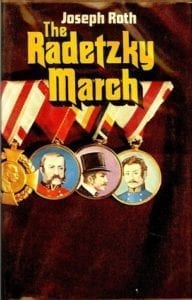Sally Metzler
Chicago, Illinois, United States

Madness and decay of society permeate Joseph Roth’s brooding novel The Radetsky March (1932). One character, Herr von Taussig, experiences attacks of “circular insanity.”1 The recommended cure is an institution on Lake Constance, where Von Taussig receives treatment by “mundane and feather-brained physicians who prescribe ‘spiritual emotions,’ just as frivolously as old-fashioned family doctors prescribed rhubarb and castor oil.” Despite the attentive care, Von Taussig suffers attacks at an increasing rate. Thus the physician is castigated for his inability to abate Von Taussig’s afflictions, the ineptitude symbolic of the “circular insanity” or malady afflicting the Austro Hungarian Empire—the real protagonist of the novel.
The 1859 Battle of Solferino, in which Italian and French troops defeated Austrian domination, forms the backdrop of Roth’s narrative that chronicles the vagaries of fame and fortune encountered by three generations of the Austrian Von Trotta family. Heroes and anti-heroes compete for the reader’s sympathies. The novel opens with a momentous, life-altering deed of Von Trotta: at the Battle of Solferino, he placed himself in front of Emperor Franz Joseph and took a bullet himself to spare the life of the then twenty-nine year old Emperor. The bullet shattered Von Trotta’s left clavicle and lodged itself in his left shoulder blade; under the watchful eye of the Kaiser, the bullet was removed and Von Trotta made a speedy recovery.
Within weeks, Lieutenant Von Trotta was knighted and raised to the rank of Captain. That one courageous act would be the lightning rod throughout the novel, a virtue and vice for the Von Trotta progeny as either source of pride, or constant reminder of a larger-than-life ancestor. The third Von Trotta offspring, Carl Josef, was profligate and derelict of his military office, preferring the sensual comforts of an older married woman than the training field, along with a heavy dose of local gin. Though he felt the weight of his illustrious ancestry a burden, Carl Josef was saved from ruin on one more than one occasion precisely because of his grandfather’s bravery and connection to the Kaiser. But in the end, this third and final member of the Von Trotta dynasty died on the battlefield, a bullet pierced his skull while he was carrying water pails for his parched regiment. Unlike his grandfather, the Hero of Solferino, he would neither be knighted nor remembered post-mortem for his deeds, thus symbolic of a bygone era for a single family and the Austro-Hungarian Empire itself.

Musée du Second Empire, Compiègne France.
Reference
Roth, Joseph. The Radetzky March. New York: Overlook Press, 2002, 187. First published in German in Berlin, 1932; English translation cited.
SALLY METZLER, Ph.D., is the Director of the Art Collection for the Union League Club Chicago.

Leave a Reply